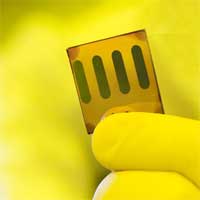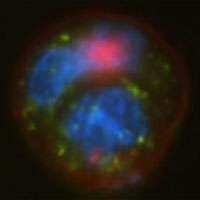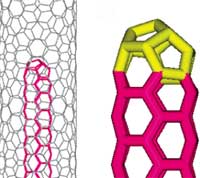Showing Spotlights 2329 - 2336 of 2838 in category All (newest first):
 'Field evaporation' is the phenomenon by which surface atoms are ionized (evaporated) under an applied, extremely high electric field of the order of several volts per nanometer. Electric fields of this magnitude can only be achieved by applying a high field to an extremely sharp needle such as the specimen tip in a Field Ion Microscope. Field evaporation was first reported over 50 years ago and has since developed into the powerful Atom Probe Field Ion Microscopy which is able to reproduce the atomic structure of a piece of material in three dimensions. Today, field evaporation is mainly used for material characterization, and the behavior of nanomaterials at extremely strong electric fields is of great scientific and technological interest. In principle, the field evaporation phenomenon can be utilized not only for materials characterization, but also for materials processing and morphology control with extremely high precision because of its unique atom-by-atom removal capability. However, detailed structural evolution of nanomaterials during field evaporation has never been directly observed and this limitation has greatly restricted the potential applications of field evaporation as a materials-processing tool. Now, researchers in Beijing have reported the first direct observation of field evaporation phenomena using a transmission electron microscopy (TEM) technique. By conducting in situ TEM field evaporation experiments on individual carbon nanotubes (CNTs), the researchers were able to reveal details about the structural evolution of the nanomaterials via direct observation. Using this technique, they have been able to perform controlled engineering of the CNTs with atomic precision, for example, grinding and shortening of CNTs, shaping of the open ends of CNTs, and opening of CNT caps.
'Field evaporation' is the phenomenon by which surface atoms are ionized (evaporated) under an applied, extremely high electric field of the order of several volts per nanometer. Electric fields of this magnitude can only be achieved by applying a high field to an extremely sharp needle such as the specimen tip in a Field Ion Microscope. Field evaporation was first reported over 50 years ago and has since developed into the powerful Atom Probe Field Ion Microscopy which is able to reproduce the atomic structure of a piece of material in three dimensions. Today, field evaporation is mainly used for material characterization, and the behavior of nanomaterials at extremely strong electric fields is of great scientific and technological interest. In principle, the field evaporation phenomenon can be utilized not only for materials characterization, but also for materials processing and morphology control with extremely high precision because of its unique atom-by-atom removal capability. However, detailed structural evolution of nanomaterials during field evaporation has never been directly observed and this limitation has greatly restricted the potential applications of field evaporation as a materials-processing tool. Now, researchers in Beijing have reported the first direct observation of field evaporation phenomena using a transmission electron microscopy (TEM) technique. By conducting in situ TEM field evaporation experiments on individual carbon nanotubes (CNTs), the researchers were able to reveal details about the structural evolution of the nanomaterials via direct observation. Using this technique, they have been able to perform controlled engineering of the CNTs with atomic precision, for example, grinding and shortening of CNTs, shaping of the open ends of CNTs, and opening of CNT caps.
Mar 7th, 2008
 Harnessing the power of the sun to replace the use of fossil fuels holds tremendous promise. One way to do this is through the use of solar, or photovoltaic, cells. Large-scale installation already show the technical feasibility of this technology although the major problem of photovoltaic solar energy - its relative inefficiency - still needs to be overcome to make the cost of electricity produced by solar cells equal or less than electricity produced by nuclear or fossil fuels. Until now, solar cells that convert sunlight to electric power have been dominated by solid state junction devices, often made of silicon wafers. Efforts are being made in laboratories worldwide to design ordered assemblies of semiconductor nanostructures, metal nanoparticles and carbon nanotubes for constructing next generation solar energy conversion devices. Quantum dots have been identified as important light harvesting material for building highly efficient solar cells. Quantum dots are nanoscale semiconductor structures which, when exposed to light at certain wavelengths, can generate free electrons and create an electrical current. Quantum dot technology represents an exciting field of research in solar energy yet the actual research results to use them in solar cells are relatively limited. By combining spectroscopic and photoelectrochemical techniques, researchers now have demonstrated size-dependent charge injection from different-sized cadmium selenide (CdSe) quantum dots into titanium dioxide nanoparticles and nanotubes, showing a way to maximize the light absorption of quantum dot-based solar cells. Termed 'rainbow solar cells', these next-generation solar cells consist of different size quantum dots assembled in an orderly fashion. Just as a rainbow displays multiple colors of the visible light spectrum, the 'rainbow solar cell' has the potential to simultaneously absorb multiple wavelengths of light and convert it to electricity in a very efficient manner.
Harnessing the power of the sun to replace the use of fossil fuels holds tremendous promise. One way to do this is through the use of solar, or photovoltaic, cells. Large-scale installation already show the technical feasibility of this technology although the major problem of photovoltaic solar energy - its relative inefficiency - still needs to be overcome to make the cost of electricity produced by solar cells equal or less than electricity produced by nuclear or fossil fuels. Until now, solar cells that convert sunlight to electric power have been dominated by solid state junction devices, often made of silicon wafers. Efforts are being made in laboratories worldwide to design ordered assemblies of semiconductor nanostructures, metal nanoparticles and carbon nanotubes for constructing next generation solar energy conversion devices. Quantum dots have been identified as important light harvesting material for building highly efficient solar cells. Quantum dots are nanoscale semiconductor structures which, when exposed to light at certain wavelengths, can generate free electrons and create an electrical current. Quantum dot technology represents an exciting field of research in solar energy yet the actual research results to use them in solar cells are relatively limited. By combining spectroscopic and photoelectrochemical techniques, researchers now have demonstrated size-dependent charge injection from different-sized cadmium selenide (CdSe) quantum dots into titanium dioxide nanoparticles and nanotubes, showing a way to maximize the light absorption of quantum dot-based solar cells. Termed 'rainbow solar cells', these next-generation solar cells consist of different size quantum dots assembled in an orderly fashion. Just as a rainbow displays multiple colors of the visible light spectrum, the 'rainbow solar cell' has the potential to simultaneously absorb multiple wavelengths of light and convert it to electricity in a very efficient manner.
Mar 6th, 2008
 Years of engineering research and design, together with uncounted billions of dollars from government and industry, went into the development of the modern petroleum industry. It would be unreasonable to expect that we can replace this industry with greener alternatives without a similarly expansive and sustained effort. Point in case is a recently published roadmap to 'Next Generation Hydrocarbon Biorefineries' that outlines a number of novel process pathways for biofuels production based on scientific and engineering proofs of concept demonstrated in laboratories around the world. The key conclusion from this (U.S.-centric) report is that 'while the U.S. has made a significant investment in technologies focusing on breaking the biological barriers to biofuels, principally ethanol, there has not been a commensurate investment in the research needed to break the chemical and engineering barriers to hydrocarbon fuels such as gasoline, diesel, and jet fuel.' This statement of course holds true not only for biofuels but for any kind of green energy technology. The production of ethanol from corn has come under intense scrutiny and discussion for its potential environmental and economic side effects. Advances in agriculture and biotechnology have made it possible to inexpensively produce lignocellulosic biomass (plant biomass that is composed of cellulose and lignin) at costs that are significantly lower (about $15 per barrel of oil energy equivalent) than crude oil. The key bottleneck for lignocellulosic-derived biofuels is the lack of technology for the efficient conversion of biomass into liquid fuels. Advances in nanotechnology have given us an unprecedented ability to understand and control chemistry at the molecular scale, which promises to accelerate the development of biomass-to-fuels production technologies.
Years of engineering research and design, together with uncounted billions of dollars from government and industry, went into the development of the modern petroleum industry. It would be unreasonable to expect that we can replace this industry with greener alternatives without a similarly expansive and sustained effort. Point in case is a recently published roadmap to 'Next Generation Hydrocarbon Biorefineries' that outlines a number of novel process pathways for biofuels production based on scientific and engineering proofs of concept demonstrated in laboratories around the world. The key conclusion from this (U.S.-centric) report is that 'while the U.S. has made a significant investment in technologies focusing on breaking the biological barriers to biofuels, principally ethanol, there has not been a commensurate investment in the research needed to break the chemical and engineering barriers to hydrocarbon fuels such as gasoline, diesel, and jet fuel.' This statement of course holds true not only for biofuels but for any kind of green energy technology. The production of ethanol from corn has come under intense scrutiny and discussion for its potential environmental and economic side effects. Advances in agriculture and biotechnology have made it possible to inexpensively produce lignocellulosic biomass (plant biomass that is composed of cellulose and lignin) at costs that are significantly lower (about $15 per barrel of oil energy equivalent) than crude oil. The key bottleneck for lignocellulosic-derived biofuels is the lack of technology for the efficient conversion of biomass into liquid fuels. Advances in nanotechnology have given us an unprecedented ability to understand and control chemistry at the molecular scale, which promises to accelerate the development of biomass-to-fuels production technologies.
Mar 5th, 2008
 Nanotechnology is already part of the process through which silicon-based photovoltaic solar cells - which make up some 95 percent of the solar cell market today - produce electricity. Nanotechnology is also the focus of research and development of a new generation of solar power technology that includes organic and inorganic solar cells derived from nanocrystals that can convert sunlight into electricity at a fraction of the cost of silicon solar cells. Silicon-based solar cells are made from a refined, highly purified silicon crystal, similar to those used in the manufacture of integrated circuits and computer chips. The high cost of these silicon solar cells and their complex production process has generated interest in developing alternative photovoltaic technologies. Compared to silicon-based devices, polymer solar cells are lightweight (which is important for small autonomous sensors), disposable, inexpensive to fabricate, flexible, designable on the molecular level, and have little potential for negative environmental impact. These solar nanocells are so small and pliable that they can be painted onto physical structures so that the windows and walls of a building may one day soon be able to generate electricity. The big question today is to what degree polymer solar cells will be able to commercially compete with silicon solar cells. There are two major issues that need to be solved: 1) The present efficiency of organic solar cells lies at only around 6 percent, compared to up to 30 percent for the most efficient silicon cells. 2) Polymer solar cells suffer from huge degradation effects: the efficiency is decreased over time due to environmental effects such as water, oxygen or UV rays.
Nanotechnology is already part of the process through which silicon-based photovoltaic solar cells - which make up some 95 percent of the solar cell market today - produce electricity. Nanotechnology is also the focus of research and development of a new generation of solar power technology that includes organic and inorganic solar cells derived from nanocrystals that can convert sunlight into electricity at a fraction of the cost of silicon solar cells. Silicon-based solar cells are made from a refined, highly purified silicon crystal, similar to those used in the manufacture of integrated circuits and computer chips. The high cost of these silicon solar cells and their complex production process has generated interest in developing alternative photovoltaic technologies. Compared to silicon-based devices, polymer solar cells are lightweight (which is important for small autonomous sensors), disposable, inexpensive to fabricate, flexible, designable on the molecular level, and have little potential for negative environmental impact. These solar nanocells are so small and pliable that they can be painted onto physical structures so that the windows and walls of a building may one day soon be able to generate electricity. The big question today is to what degree polymer solar cells will be able to commercially compete with silicon solar cells. There are two major issues that need to be solved: 1) The present efficiency of organic solar cells lies at only around 6 percent, compared to up to 30 percent for the most efficient silicon cells. 2) Polymer solar cells suffer from huge degradation effects: the efficiency is decreased over time due to environmental effects such as water, oxygen or UV rays.
Mar 4th, 2008
 Since their discovery in 1961, liposomes - nanoscale vesicles composed of phospholipids - have been developed as nano-vectors that are used for a variety of biomedical applications including diagnostic imaging, gene therapy, biosensing and targeted drug delivery. In fact, the FDA-approved drugs Ambisome, Doxil and DaunoXome all contain liposomal formulations. Such liposomes are typically comprised of glycerol-based phospholipids that contain a hydrophilic (water-soluble) head-group and one or two hydrophobic (water-insoluble) hydrocarbon chains of varying length. In aqueous solution, these phospholipids self-assemble into a lipid bilayer, with the hydrophilic lipid groups oriented toward the aqueous solution and the hydrophobic groups protected in the bilayer's interior. The bilayers form spherical vesicles that are used to carry drugs and diagnostic imaging agents to sites of interest within the body. The hollow interior of the vesicles is hydrophilic and can easily encapsulate a variety of hydrophilic drugs or imaging agent molecules, which are then released from the liposomes in a controlled fashion. But what about hydrophobic molecules - those that aren't water-soluble and therefore aren't easily encapsulated within the interior of traditional phospholipid liposomes? Many beneficial, yet water-insoluble drugs do exist, but the current methods used to administer to these drugs to patients, such as dissolving them in alcohols, castor oil or other hydrophobic liquids for injection, can cause patients much discomfort or other side effects. For these reasons, the development of a nano-vector with a hydrophobic interior - one that could successfully encapsulate and release hydrophobic molecules - is of great interest to the nanomedicine community.
Since their discovery in 1961, liposomes - nanoscale vesicles composed of phospholipids - have been developed as nano-vectors that are used for a variety of biomedical applications including diagnostic imaging, gene therapy, biosensing and targeted drug delivery. In fact, the FDA-approved drugs Ambisome, Doxil and DaunoXome all contain liposomal formulations. Such liposomes are typically comprised of glycerol-based phospholipids that contain a hydrophilic (water-soluble) head-group and one or two hydrophobic (water-insoluble) hydrocarbon chains of varying length. In aqueous solution, these phospholipids self-assemble into a lipid bilayer, with the hydrophilic lipid groups oriented toward the aqueous solution and the hydrophobic groups protected in the bilayer's interior. The bilayers form spherical vesicles that are used to carry drugs and diagnostic imaging agents to sites of interest within the body. The hollow interior of the vesicles is hydrophilic and can easily encapsulate a variety of hydrophilic drugs or imaging agent molecules, which are then released from the liposomes in a controlled fashion. But what about hydrophobic molecules - those that aren't water-soluble and therefore aren't easily encapsulated within the interior of traditional phospholipid liposomes? Many beneficial, yet water-insoluble drugs do exist, but the current methods used to administer to these drugs to patients, such as dissolving them in alcohols, castor oil or other hydrophobic liquids for injection, can cause patients much discomfort or other side effects. For these reasons, the development of a nano-vector with a hydrophobic interior - one that could successfully encapsulate and release hydrophobic molecules - is of great interest to the nanomedicine community.
Mar 3rd, 2008
 Since their discovery, the single-walled carbon nanotube (SWCNT) has evolved into one of the most intensively studied materials. A SWCNT can be regarded as a monolayer of a graphene sheet rolled up to form a seamless cylinder with axial symmetry and in general exhibiting a spiral conformation called chirality. Chirality is defined by a single vector called the chiral vector (n,m). This chiral vector is dependent on the orientation of the tube axis with respect to the hexagonal lattice. SWCNTs with different chiral vectors have dissimilar properties such as optical activity, mechanical strength and electrical conductivity. An obvious question that has been around since their discovery, but so far has not been satisfactorily answered, is how small the smallest SWCNT is. Theoretical calculations predict that the smallest diameter for a stable SWCNT is around 0.4 nm, and there are three possible structures that correspond with this value - chiral vectors (5,0), (3,3) or (4,2). Many efforts have been made to produce the smallest SWCNT and identify its atomic structure, but the techniques used were not accurate enough. Consequently, until now, the diameter and structure of the smallest possible carbon nanotube have remained in doubt. Not anymore, though. Researchers in Japan, affiliated with Sumio Iijima, the discoverer of carbon nanotubes, have successfully synthesized the smallest SWCNTs with a diameter of 0.4 nm by thermal decomposition of ferrocene molecules inside commercial-grade SWCNTs with a diameter of 1.1 nm. Apart from the scientific aspects of these findings, using the inner space of a carbon nanotube as a reaction cell appears to be an intriguing approach to fabricating new structures which would be unstable on their own.
Since their discovery, the single-walled carbon nanotube (SWCNT) has evolved into one of the most intensively studied materials. A SWCNT can be regarded as a monolayer of a graphene sheet rolled up to form a seamless cylinder with axial symmetry and in general exhibiting a spiral conformation called chirality. Chirality is defined by a single vector called the chiral vector (n,m). This chiral vector is dependent on the orientation of the tube axis with respect to the hexagonal lattice. SWCNTs with different chiral vectors have dissimilar properties such as optical activity, mechanical strength and electrical conductivity. An obvious question that has been around since their discovery, but so far has not been satisfactorily answered, is how small the smallest SWCNT is. Theoretical calculations predict that the smallest diameter for a stable SWCNT is around 0.4 nm, and there are three possible structures that correspond with this value - chiral vectors (5,0), (3,3) or (4,2). Many efforts have been made to produce the smallest SWCNT and identify its atomic structure, but the techniques used were not accurate enough. Consequently, until now, the diameter and structure of the smallest possible carbon nanotube have remained in doubt. Not anymore, though. Researchers in Japan, affiliated with Sumio Iijima, the discoverer of carbon nanotubes, have successfully synthesized the smallest SWCNTs with a diameter of 0.4 nm by thermal decomposition of ferrocene molecules inside commercial-grade SWCNTs with a diameter of 1.1 nm. Apart from the scientific aspects of these findings, using the inner space of a carbon nanotube as a reaction cell appears to be an intriguing approach to fabricating new structures which would be unstable on their own.
Feb 29th, 2008
 When two surfaces approach each other in air, they attract. A phenomenon that is explained by van der Waals forces that affect molecules' interaction. Without these - very weak - intermolecular forces, life as we know it would be impossible. They are responsible for a number of properties of molecular compounds, including crystal structures, condensing, melting and boiling points, surface tension, and densities. Intermolecular forces form molecules like enzymes, proteins, and DNA into the shapes required for biological activity. Van der Waals forces can also be repulsive, for instance when two surfaces approach each other in liquid: the same force which causes attraction in air (and which is responsible for so called stiction and adhesion) can be made repulsive by choosing the right combination of surface materials and intervening liquid. This force has the characteristic that it increases very rapidly with very small changes in separation when the surfaces are close to each other. Researchers now have shown that if repulsive van der Waals forces exist between two surfaces prior to their contact then friction is essentially precluded and supersliding is achieved. This opens the possibility that, in certain material systems, the controlled use of repulsive van der Waals forces could be a way to reduce, if not eliminate, friction.
When two surfaces approach each other in air, they attract. A phenomenon that is explained by van der Waals forces that affect molecules' interaction. Without these - very weak - intermolecular forces, life as we know it would be impossible. They are responsible for a number of properties of molecular compounds, including crystal structures, condensing, melting and boiling points, surface tension, and densities. Intermolecular forces form molecules like enzymes, proteins, and DNA into the shapes required for biological activity. Van der Waals forces can also be repulsive, for instance when two surfaces approach each other in liquid: the same force which causes attraction in air (and which is responsible for so called stiction and adhesion) can be made repulsive by choosing the right combination of surface materials and intervening liquid. This force has the characteristic that it increases very rapidly with very small changes in separation when the surfaces are close to each other. Researchers now have shown that if repulsive van der Waals forces exist between two surfaces prior to their contact then friction is essentially precluded and supersliding is achieved. This opens the possibility that, in certain material systems, the controlled use of repulsive van der Waals forces could be a way to reduce, if not eliminate, friction.
Feb 28th, 2008
 The process of bringing a major new drug to market, from discovery to marketing, takes about 10-12 years and costs an average of $500-$800 million in industrialized countries. And still, most drugs fail before they even make it to market. About 80 percent of drugs never make it through their clinical trials. Of the medications that actually enter consumer use, an average of just 60 percent provide therapeutic benefits to patients. For a pharmaceutical company the results of the process designing new drugs leads to a library of novel compounds that are created with a specific goal, a given set of criteria. Often these criteria include the selectivity for a particular known receptor. A new drug treatment can be discovered by testing those drugs on other receptors by trial and error. Since this is a very expensive approach, pharma companies have developed sophisticated computer models that help reduce the risk and uncertainty inherent in the drug-development process. Here, one starts with a computer model of the structure of a receptor and a drug. The goal is to predict by simulation how a drug will dock (interact with a receptor), or how the receptor will fold. Drug design based on mathematical models will also become a massive task within the emerging field of nanomedicine. Although nanotechnology offers great visions of improved, personalized treatment of disease, at the same time it renders the problem of selecting the candidates for biological testing astronomically more complex. The new notion of 'design maps' for nanovectors - similar to the concept of the periodic table for chemical elements - could provide guidance for the development of optimized injectable nanocarriers through mathematical modeling.
The process of bringing a major new drug to market, from discovery to marketing, takes about 10-12 years and costs an average of $500-$800 million in industrialized countries. And still, most drugs fail before they even make it to market. About 80 percent of drugs never make it through their clinical trials. Of the medications that actually enter consumer use, an average of just 60 percent provide therapeutic benefits to patients. For a pharmaceutical company the results of the process designing new drugs leads to a library of novel compounds that are created with a specific goal, a given set of criteria. Often these criteria include the selectivity for a particular known receptor. A new drug treatment can be discovered by testing those drugs on other receptors by trial and error. Since this is a very expensive approach, pharma companies have developed sophisticated computer models that help reduce the risk and uncertainty inherent in the drug-development process. Here, one starts with a computer model of the structure of a receptor and a drug. The goal is to predict by simulation how a drug will dock (interact with a receptor), or how the receptor will fold. Drug design based on mathematical models will also become a massive task within the emerging field of nanomedicine. Although nanotechnology offers great visions of improved, personalized treatment of disease, at the same time it renders the problem of selecting the candidates for biological testing astronomically more complex. The new notion of 'design maps' for nanovectors - similar to the concept of the periodic table for chemical elements - could provide guidance for the development of optimized injectable nanocarriers through mathematical modeling.
Feb 27th, 2008
 'Field evaporation' is the phenomenon by which surface atoms are ionized (evaporated) under an applied, extremely high electric field of the order of several volts per nanometer. Electric fields of this magnitude can only be achieved by applying a high field to an extremely sharp needle such as the specimen tip in a Field Ion Microscope. Field evaporation was first reported over 50 years ago and has since developed into the powerful Atom Probe Field Ion Microscopy which is able to reproduce the atomic structure of a piece of material in three dimensions. Today, field evaporation is mainly used for material characterization, and the behavior of nanomaterials at extremely strong electric fields is of great scientific and technological interest. In principle, the field evaporation phenomenon can be utilized not only for materials characterization, but also for materials processing and morphology control with extremely high precision because of its unique atom-by-atom removal capability. However, detailed structural evolution of nanomaterials during field evaporation has never been directly observed and this limitation has greatly restricted the potential applications of field evaporation as a materials-processing tool. Now, researchers in Beijing have reported the first direct observation of field evaporation phenomena using a transmission electron microscopy (TEM) technique. By conducting in situ TEM field evaporation experiments on individual carbon nanotubes (CNTs), the researchers were able to reveal details about the structural evolution of the nanomaterials via direct observation. Using this technique, they have been able to perform controlled engineering of the CNTs with atomic precision, for example, grinding and shortening of CNTs, shaping of the open ends of CNTs, and opening of CNT caps.
'Field evaporation' is the phenomenon by which surface atoms are ionized (evaporated) under an applied, extremely high electric field of the order of several volts per nanometer. Electric fields of this magnitude can only be achieved by applying a high field to an extremely sharp needle such as the specimen tip in a Field Ion Microscope. Field evaporation was first reported over 50 years ago and has since developed into the powerful Atom Probe Field Ion Microscopy which is able to reproduce the atomic structure of a piece of material in three dimensions. Today, field evaporation is mainly used for material characterization, and the behavior of nanomaterials at extremely strong electric fields is of great scientific and technological interest. In principle, the field evaporation phenomenon can be utilized not only for materials characterization, but also for materials processing and morphology control with extremely high precision because of its unique atom-by-atom removal capability. However, detailed structural evolution of nanomaterials during field evaporation has never been directly observed and this limitation has greatly restricted the potential applications of field evaporation as a materials-processing tool. Now, researchers in Beijing have reported the first direct observation of field evaporation phenomena using a transmission electron microscopy (TEM) technique. By conducting in situ TEM field evaporation experiments on individual carbon nanotubes (CNTs), the researchers were able to reveal details about the structural evolution of the nanomaterials via direct observation. Using this technique, they have been able to perform controlled engineering of the CNTs with atomic precision, for example, grinding and shortening of CNTs, shaping of the open ends of CNTs, and opening of CNT caps.
 Subscribe to our Nanotechnology Spotlight feed
Subscribe to our Nanotechnology Spotlight feed





